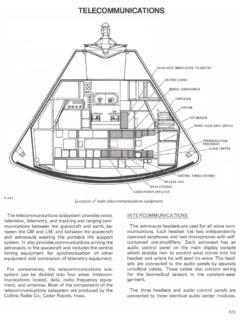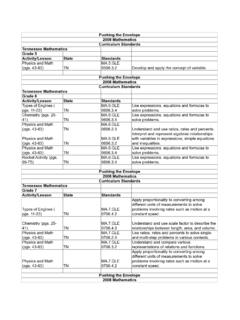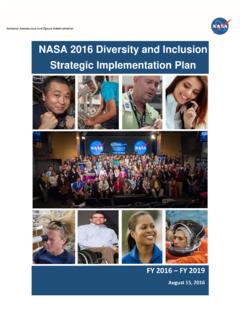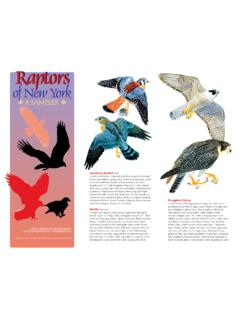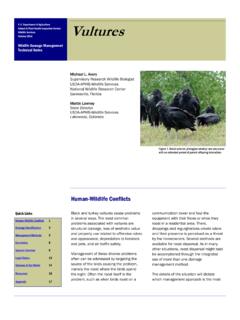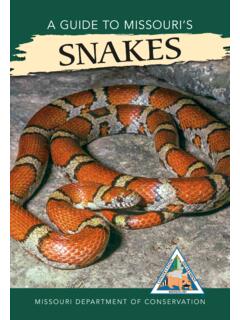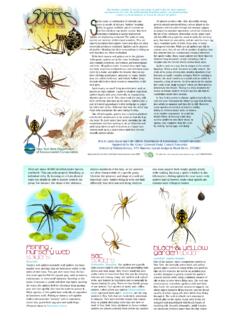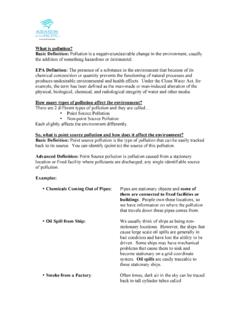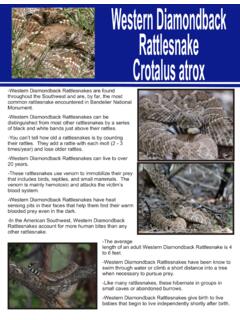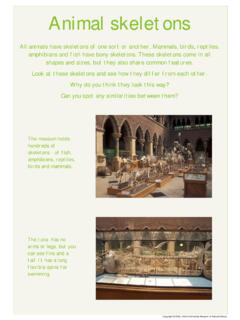Transcription of Wing Design
1 National Aeronautics and Space Administration GRADES K-12. Wing Design Aeronautics Research Mission parts of an airplane Directorate Museum in a BOXS eries MUSEUM IN A BOX. (Photo courtesy of NASA - ). Wing Design Lesson Overview In this lesson, students will learn about forces, motion, and properties of objects and materials through the concepts of basic wing Design . They will begin by exploring birds' wings and discovering the properties required for successful flight. Next they will move to basic aircraft wing shapes and finally, calculate some basic wing parameters. Objectives Materials: Students will: In the Box 1. Discover how the feathers on different varieties of Ostrich Feather birds relate to their ability to fly. Turkey Feather 2. Learn how airplane wings are designed for specific tasks and situations. 3. Learn the basic math behind wing Design . Provided by User Ruler GRADES K-12 Time Requirements: 1 hour 10 minutes 2. parts of an airplane MUSEUM IN A BOX.
2 Background Wing Design Wing Design is constantly evolving. If you were to compare the wing of the Wright Flyer (Img. 1) with that of a modern aircraft, such as the Boeing 787 (Img. 2), the difference is remarkable. The number of lifting surfaces, shape, size and materials used all contribute to an aircraft's performance. (Photo courtesy of Wikipedia, GNU Free Documentation License). Since the 1930's, NASA and its predecessor NACA have been Img. 1 The 1903 Wright Flyer on the forefront of wing Design , developing the basic airfoil shapes airplane manufacturers have used ever since to provide the lift component that is vital to air travel. Before a wing is designed, its mission has to be determined. What type of aircraft will this wing be attached to? Will it need to operate at high altitudes with thin atmospheres? Will it have to carry heavy loads? Will it need space to mount the engines? How much fuel will we want to store inside? How (Photo courtesy of Boeing).
3 Fast or agile will the aircraft need to be? The list of potential specifications is long and highly complex. Img. 2 Boeing 787. The same type of Design challenges can be seen in nature with our feathered friends, the birds. While all birds have wings, not every bird can fly. Take the ostrich (Img. 3) for example. It is a large bird , weighing on average nearly 200. pounds, but its wings are short and its feathers are fluffy and undefined. No matter how hard it tries, the wing will never be able to produce enough lift for the ostrich to fly. (Photo courtesy of Lost Tribe Media, Inc.). Img. 3 An ostrich with folded wings parts of an airplane 3. The seagull (Img. 4) on the other hand is a small bird , weighing MUSEUM IN A BOX. barely 2 pounds, but has long, thin wings which are perfect for gliding on the coastal breezes. It needs airflow over the wing to work though, so in order to fly the bird has to first run forwards to increase the airflow over its wings, just as a plane would on the runway.
4 The robin (Img. 5) uses a very different style of wing. To avoid ((Photo courtesy of Arnold Paul, CC BY-SA License). predators such as cats, it needs to be able to jump quickly into the air and does so using short, fast moving wings that provide Img. 4 A seagull in flight lots of lift, but at the sacrifice of forward speed. Lastly, some predatory birds, such as hawks, need the ability to fly quickly in order to catch their prey , but also need to carry the meal home to their offspring. To achieve this, they are able to fold their wings back while diving, giving them a fast, sleek appearance for the attack, but a wide, large wingspan for carrying heavy loads on the journey home. (Photo courtesy of Fauxpasgrapher, CC BY-NC-ND License). Img. 5 A robin in flight 4. parts of an airplane MUSEUM IN A BOX. Compromises As with everything in life there are compromises and this is no different with wing Design . While each Design works well, they all have limitations or restrictions making them suitable only for certain tasks.)
5 Rectangular Wing: The rectangular wing, sometimes referred to as the Hershey Bar wing in reference to the candy bar it resembles, is a good general purpose wing. It can carry a reasonable load and fly at a reasonable speed, but does nothing superbly well. It is ideal for personal aircraft as it is easy to control in the air as well as inexpensive to build and maintain. Elliptical Wing: The elliptical wing is similar to the rectangular wing and was common on tail-wheel aircraft produced in the 1930s and 40s. It excels however in use on gliders, where its long wingspan can capture the wind currents easily, providing lift without the need for a lot of forward momentum, or airspeed. Swept Wing: The swept wing is the go to wing for jet powered aircraft. It needs more forward speed to produce lift than the rectangular wing, but produces much less drag in the process, meaning that the aircraft can fly faster. It also works well at the higher altitudes, which is where most jet aircraft fly.
6 Delta Wing: The delta wing advances the swept wing concept, pulling the wings even further back and creating even less drag. The downside to this however is that the aircraft has to fly extremely fast for this wing to be effective. This is why it's only found on supersonic aircraft (aircraft that fly faster than the speed of sound) such as fighter jets and the Space Shuttle orbiter. There were also two commercial passenger jets that used this wing Design , the Russian TU-144 (Img. 6) and BOAC's Concorde (Img. 7), both of which could cruise at supersonic speeds. parts of an airplane 5. MUSEUM IN A BOX. (Photo courtesy of NASA). Img. 6 A Russian TU-144 Supersonic Passenger Jet (Photo courtesy of Henrysalome & Wikipedia (GNU Free Documentation License)). Img. 7 The BOAC Concorde Supersonic Passenger Jet 6. parts of an airplane MUSEUM IN A BOX. Wing Construction & Mathematics The earliest wings were designed mostly through trial and error, using drawings and small scale models to test theories.
7 Today though, we can precisely calculate a wing's performance before it ever leaves the ground. Below are some terms related to wings and the mathematics behind wing Design . Skin: The outer surface of the wing. Originally made of fabric, modern aircraft use aluminum or composite materials due to their lightweight and rust-resistant properties. Ribs & Stringers: These make up the inner skeleton of the wing, providing rigidity and strength. While strength is necessary, it is also important that the wing can flex slightly while it flies. This flexibility allows it to absorb the stress caused by turbulence and hard landings. Spar: The main center beam of the wing, designed to carry the structural loads and transfer them by attachment to the fuselage, or body, of the aircraft. Root Flap Spar Fuel Tank: Commonly located in the wing, fuel can either be housed in its own tank or allowed to Fuel tank Aileron fill the cavities between the ribs. In addition to powering the engines, the fuel adds rigidity to the wing.
8 Slats Ribs Flaps: Are a high lift / Wing tip high drag device. Not Stringers only do they improve the Fig. 1 The components of a wing lifting ability of the wing at slower speeds by changing the camber, or curvature of the wing, they also create more drag, meaning an aircraft can descend, or lose altitude faster, without gaining airspeed in the process. Root: The wing root is the portion of the wing that attaches to the fuselage, or body of the aircraft. Wing Tip: The wing tip is furthest from the fuselage and is typically where the navigation lights are mounted (a red light on the left, a green light on the right). Slats: Another high lift device typically found on swept or delta wing aircraft. Slats are similar to the flaps except they are mounted on the leading edge of the wing. They also assist in changing the camber to improve lifting ability at slower speeds. parts of an airplane 7. MUSEUM IN A BOX. Wing Construction & Mathematics (cont.). Aspect Ratio: The ratio of the wing's length to its chord line.
9 A wing with a high aspect ratio will perform well at slow speeds and produce large quantities of lift, but at the expense of maneuverability and airspeed. A wing with a low aspect ratio on the other hand will have a sleek appearance and allow an aircraft to fly faster, or be more maneuverable. Camber: The name given to the curvature of the upper or lower surfaces of the wing. A higher camber, or more curved surface, results in an aircraft that can fly at slower speeds while still generating sufficient lift for flight. Chord Line: The theoretical line running from the leading edge of the wing to the trailing edge. Leading Edge: The front edge of an aircraft's wing. Trailing Edge: The rear edge of an aircraft's wing. Trailing Edge Leading Edge Chord Line Fig. 2 Wing cross-section For additional information on wing Design and aerodynamics, please refer to the Museum In A Box lessons Four Forces and Bernoulli Principle . 8. parts of an airplane MUSEUM IN A BOX.
10 Activity 1 Avian Wing Comparison GRADES K-12 Time Requirement: 20 minutes Materials: Objective: In the Box In this activity, students will discover how the feathers on different species of birds relate to their ability to fly. Ostrich Feather Turkey Feather Activity Overview: Provided by User Students will compare the feather characteristics of both flying and non-flying birds and determine how the Design of the feather correlates to the ability of the bird to fly. None Activity: Worksheets 1. Begin by discussing with the students the Avian Feather Comparison Background information provided. (Worksheet 1). 2. Pass around each of the feathers and Reference Materials their associated images while asking the Img. 8 Turkey students to determine which feather Img. 9 Ostrich came from which bird . (Photo courtesy of the United States 3. Have the students list the characteristics Key Terms: Department of Agriculture). of both the bird and the feather on their Img.
